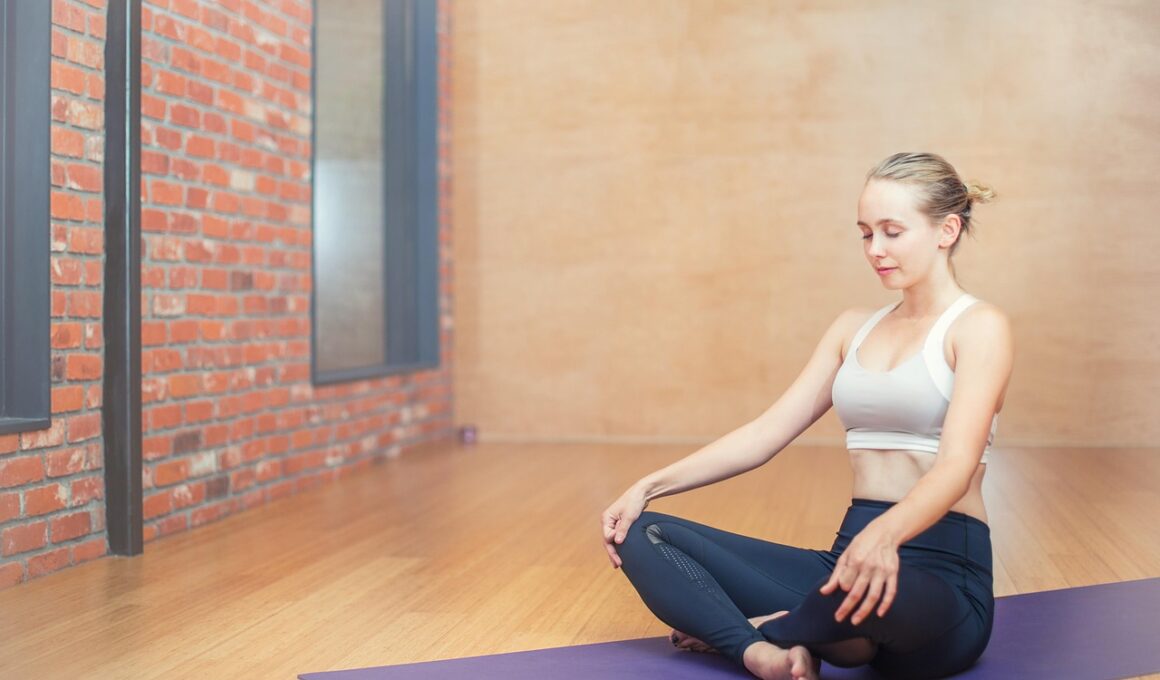Meditation Tips for Beginners to Complement Your Yoga Practice
Starting a yoga journey is an exciting time, and incorporating meditation is an excellent way to enhance that experience. Meditation offers a unique opportunity to calm the mind, making it easier to focus during yoga practice. One effective technique is to create a designated space for meditation, such as a quiet corner in your home where distractions are minimized. Use soft lighting, comfortable cushions, and calming scents like lavender or sandalwood. Setting the mood can significantly enhance your experience. Moreover, integrating meditation before or after your yoga sessions can deepen your practice. Begin with a few minutes of mindful breathing before you roll out your mat; this helps center your thoughts. If you’re more advanced, try meditating post-yoga to reflect on your practice and promote relaxation. Regular meditation can also help you become more aware of your body and breath, which is beneficial while practicing yoga. This awareness can lead to improvement in your poses and flexibility. Lastly, consider journaling about your experiences to track your progress and insights over time, nurturing both body and spirit.
Establishing a Meditation Routine
To reap the benefits of meditation, establishing a consistent routine is crucial. Choose a time of day that works best for you, whether it’s in the morning to set a positive tone for your day or in the evening to unwind. Additionally, start with short sessions, around five to ten minutes, and gradually increase the duration as you become more comfortable. Utilizing resources such as guided meditation apps or online videos can be helpful, especially for beginners. These resources often provide structure and direction, aiding in mastering techniques. Consider experimenting with various meditation styles such as mindfulness, loving-kindness, or body scan to discover what resonates with you most. Track your progress to stay motivated; even noting your feelings or thoughts during each session can deepen your understanding. Furthermore, joining a local meditation group or class may enhance your practice significantly. Engaging with others can provide encouragement and insights while also holding you accountable. Remember, patience and persistence are essential as meditation is a skill that develops over time. Every small step contributes to significant growth.
Breath awareness is fundamental in both yoga and meditation practices. By focusing on your breath, you create a bridge between your mind and body. Start by finding a comfortable seated position or lying down, ensuring your spine is straight. Close your eyes gently and take a moment to notice your natural breathing pattern without altering it. As thoughts arise, acknowledge them, then gently bring your focus back to your breath. This act of returning your focus strengthens your concentration and cultivates mental clarity. If you find difficulty in maintaining focus, consider using techniques such as counting breaths or visualizations. For example, you can visualize air filling your body as you inhale and releasing negativity as you exhale. This imagery enhances the meditative experience, making it more profound. Additionally, practicing deep belly breathing can significantly enhance relaxation. Inhale deeply through your nose, allowing your abdomen to expand, and exhale slowly. Repeating this will calm your nervous system and prepare your body. Incorporating breath awareness during your yoga sessions can unify both practices, leading to an enriching experience through intentionality and presence.
Creating Positive Affirmations
Another powerful element in meditation is incorporating positive affirmations, which can uplift your spirit. Repeat calming phrases like “I am calm and centered” or “I embrace peace within” during your meditation sessions to reinforce positive self-beliefs. These affirmations help rewire your subconscious mind, promoting a positive mindset, which is crucial for effective yoga practice. Start by choosing affirmations that resonate with you or create your own. Write them down in a journal or a sticky note and keep them in your meditation space for easy access. Each time you meditate, take a few minutes to focus on these affirmations, either silently or out loud. Breathing deeply while saying these words will infuse them with more meaning, reinforcing their essence. By consistently using affirmations, you’ll likely notice a shift in your perspective and increased confidence in your yoga journey. Furthermore, combining affirmations with specific yoga poses can enhance their impact. For example, while in a warrior pose, say something empowering to cultivate strength and resilience. This combination makes your practice holistic and transformative, aligning body, mind, and spirit.
Utilizing visualization techniques can greatly enhance your meditation experience. Imagine a peaceful scene like a tranquil beach or a lush forest while meditating; this creates a mental escape that promotes relaxation. Close your eyes and picture every detail vividly—the sounds, smells, and sensations of that place. Engage all your senses as this enhances the experience, allowing you to immerse fully in relaxation. As you visualize, maintain a gentle focus on your breath, using it to anchor your experience. During yoga, you can incorporate visualization by imagining yourself flowing smoothly through each pose, enhancing your movements. Picture your body executing each position with grace and ease. This not only improves your practice but also builds confidence and reduces anxiety. Additionally, visualization can aid in setting intentions for your practice. Before starting, picture what you hope to achieve. Maybe it’s improving flexibility, finding inner calm, or simply enjoying your practice. This sets a powerful intention that influences both meditation and yoga, leading to a more profound connection with yourself and your practice, ultimately enhancing your overall well-being.
Listening to Your Body
As an integral part of both yoga and meditation, listening to your body helps cultivate awareness and fosters connection. Begin by tuning into your body’s signals, such as tension or discomfort, during meditation. If you notice any soreness or strain, don’t hesitate to adjust your position or stop momentarily. The goal is to maintain comfort to deepen your practice fully. While practicing yoga, this awareness translates into adjusting poses according to your body’s needs. Respect your limitations and avoid pushing beyond what feels natural, as this can lead to injury or frustration. Acceptance is key; embrace where you are in your practice rather than striving for perfection. Acknowledge your efforts and progress, big or small. Body awareness can also enhance relaxation during meditation, allowing you to release tension that accumulates throughout the day. Focus on each body part’s sensations, starting from your toes to your head. Notice where you carry stress and consciously breathe into that area, allowing it to relax. Ultimately, nurturing this mindset promotes self-love and a more fulfilling, long-lasting yoga and meditation journey.
Connecting with nature can be remarkably beneficial for both yoga and meditation. Practicing outdoors allows you to immerse yourself in the natural world, enhancing your experience. Find a calm outdoor space like a park or garden, where you can practice yoga or meditate while breathing fresh air. Nature’s tranquility soothes the mind and sparks a connection to something larger than yourself. During meditation, focus on the sounds and sights around you, allowing them to anchor your practice. Listen to the wind rustling through leaves or birds chirping, grounding yourself in the moment. Additionally, consider incorporating outdoor yoga sessions into your routine. Each pose you practice outdoors becomes infused with energy from the environment. Experimenting with various settings can spark new inspiration and keep your practice fresh and engaging. You can also lay your yoga mat on grass or sand for added connection to the earth. This practice fosters gratitude for nature’s beauty and encourages mindfulness. By linking nature with your meditation and yoga practices, you enhance both spiritual abundance and physical well-being, creating an enriching space for growth.
In summary, integrating meditation into your yoga practice can significantly augment your overall experience, providing numerous benefits. Whether you start with breath awareness, visualization, or affirmations, the aim is to enhance your connection with your true self. Establishing a routine, practicing outdoors, and being mindful of your body fosters a holistic approach that nurtures the mind, body, and spirit. Each meditation session offers an opportunity for growth and self-discovery, encouraging reflection and improved clarity in your yoga poses. Remember that there is no right or wrong way to meditate; it’s about finding what resonates with you, making the practice uniquely yours. Embrace patience during your journey as your skills develop over time. Your persistent efforts will yield a more profound yoga practice, resulting in inner peace and enhanced flexibility. Moreover, the integration of meditation will elevate your state of mind, allowing you to approach challenges with resilience and calm understanding. Continue exploring different techniques until you find your preferences, and don’t hesitate to reach out to communities or resources that support your journey. The journey toward mastery in yoga and meditation is a fulfilling and transformative one.


